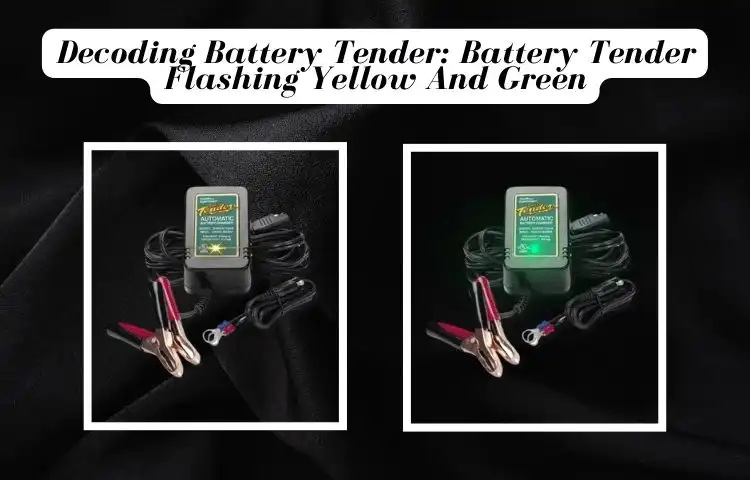Battery Tender flashing yellow and green signals play a crucial role in maintaining and understanding the charging process of your battery. Decoding these signals is essential to ensure optimal battery performance and prevent potential issues.

In this article, we will delve into the significance of Battery Tender flashing signals, explore their meanings, troubleshoot common problems, and provide valuable tips for safe and efficient usage. Understanding these signals will empower you to make informed decisions about your battery’s health and ensure its longevity.
Understanding Battery Tenders
Definition and Function of Battery Tenders
Battery tenders communicate vital information through distinct flashing patterns, with each pattern carrying a specific meaning. The most common signals involve a combination of yellow and green lights, rapid flashing, and slow flashing.

- Yellow and Green Combination
When your Battery Tender displays both yellow and green lights simultaneously, it signifies that the battery is in a state of maintenance mode. This mode is activated when the battery reaches an optimal charge level and the tender switches to a trickle charge to sustain the battery’s condition. The yellow and green combination indicates that your battery is being maintained and no further charging is required at the moment.
- Meaning of Rapid Flashing
Rapid flashing of the yellow light indicates that the battery is experiencing an abnormal charging condition. This occurrence may be attributed to a malfunction in the charging system, inadequate or faulty connections, or a battery that has incurred damage. It is important to investigate and resolve the underlying issue to ensure proper charging and prevent potential damage to the battery.
- Meaning of Slow Flashing
When the green light on your Battery Tender flashes slowly, it indicates that the battery is currently in the charging phase. This is a normal and expected behaviour during the charging process. The slow flashing green light shows that the battery is receiving a steady flow of charge and is gradually reaching its optimal level.
Interpreting Battery Tender’s Communication
- Communication through Light Signals
Battery tenders utilize light signals to convey information about the battery’s charging status and overall health. Understanding the significance of these signals grants you valuable insights into your battery’s condition, empowering you to take appropriate measures when necessary.
- Understanding the Codes
The flashing signals emitted by Battery Tenders follow specific codes that enable users to interpret the messages accurately. Familiarizing yourself with these codes will allow you to identify potential issues, troubleshoot problems, and ensure the efficient operation of your battery charger.
Unveiling the Yellow Light
Significance of Yellow Flashing
When the yellow light on your Battery Tender flashes, it indicates a potential problem with the battery or charging system. This signal warrants your attention as it signifies an issue that requires investigation and resolution.
Potential Issues and Troubleshooting
- Battery Health and Charging Level
A yellow flashing light could be an indication of a battery that is nearing the end of its lifespan or has a low charge level. In such cases, it is advisable to check the battery’s voltage using a multimeter. If the voltage is significantly below the recommended level, it may be necessary to replace the battery. However, if the battery’s voltage is within the acceptable range, the issue may lie with the charging system.
- Connection and Wiring Problems
Another potential cause of the yellow flashing light is poor connection or wiring issues. To ensure proper charging, make sure the battery terminals are impeccably clean and firmly connected to the charger.
Thoroughly examine the connections for any signs of looseness or corrosion that may impede the charging process. Additionally, carefully inspect the charger’s cables and wires, paying attention to any indications of damage or wear. Faulty connections and wiring can disrupt the charging process and trigger the yellow flashing light.
Troubleshooting these issues involves meticulously examining the battery, charger, and associated components. It is crucial to address the underlying problem promptly to prevent further battery damage and ensure a reliable charging process.
Demystifying the Green Light
Understanding the Green Flashing Signal
The presence of a green flashing light on your Battery Tender conveys a positive message, indicating that the battery is either fully charged or approaching its optimal charge level. This signal assures you that the charging process is proceeding as expected, providing peace of mind regarding your battery’s condition.
Indicators of Full Battery Charge
- Maintaining Optimal Battery Performance
When the green light on your Battery Tender remains steady, it signifies that the battery has reached its full charge. This indicates that your battery is prepared for immediate use and can provide optimal performance. At this point, the battery tender switches to maintenance mode to sustain the battery’s charge and prevent overcharging.
- Monitoring Battery’s Health
The green light’s steady illumination also serves as a convenient means to monitor your battery’s health. Regularly observing the green light’s behaviour during the charging process can help you identify any abnormalities or deviations from the normal charging cycle.
If the green light does not appear or behaves erratically, it may indicate an issue that requires further investigation or professional assistance.
Let’s address some common frequently asked questions (FAQs) regarding Battery Tender flashing yellow and green:
Why is my Battery Tender Flashing Yellow and Green Simultaneously?
If your Battery Tender is flashing yellow and green lights simultaneously, it indicates that the charger is in maintenance mode. This mode is activated when the battery reaches its optimal charge level, and the charger provides a trickle charge to sustain the battery’s condition. It is normal and expected behaviour that signifies your battery is being properly maintained.
How Long Should I Wait for the Battery to Charge?
The charging time for a battery can vary depending on various factors, such as its capacity, current charge level, and the charger’s specifications. It is recommended to consult the battery manufacturer’s guidelines or the charger’s manual for specific charging times.
While specific charging times may vary based on factors such as battery capacity and charger specifications, it is generally recommended to allow the battery ample time to reach a full charge before disconnecting it from the charger. This ensures that the battery attains its maximum charge and can provide optimal performance.
Tips for Battery Tender Usage
Best Practices for Optimal Performance
To maximize the effectiveness of your Battery Tender, consider implementing the following tips:

- Regularly inspect and clean the battery terminals to maintain good electrical contact.
- Place the battery tender in a well-ventilated area to prevent overheating.
- Follow the manufacturer’s instructions regarding the appropriate charger settings for your battery type.
- Use a compatible and quality battery tender to ensure safe and efficient charging.
Ensuring Proper Connection and Maintenance
- Ensure that the charger’s clamps or connectors are securely attached to the battery terminals.
- Check the charger’s cables and wires for any signs of damage or wear, and replace them if necessary.
- Periodically inspect the battery tender for any indications of malfunction or damage. If you notice any issues, discontinue use and seek professional assistance.
- Store the battery tender in a dry and cool environment when not in use, and avoid exposing it to extreme temperatures or moisture.
By following these tips, you can optimize the performance and lifespan of both your battery and battery tender.
Troubleshooting Battery Tender Issues
Identifying and Resolving Common Problems
In the event that you encounter issues with your battery tender, it is important to identify the underlying problem and take appropriate measures to resolve it. Some common problems include:
- Failure to Charge: If your battery tender fails to charge the battery, ensure that it is properly connected and that the battery terminals are clean. Check for any loose connections or damaged wiring. If the issue persists, it may be necessary to consult a professional for further diagnosis and repair.
- Overcharging: Overcharging can lead to battery damage and reduced lifespan. If you notice signs of overcharging, such as excessive heat or bulging battery cells, disconnect the battery tender immediately and seek professional assistance.
Seeking Professional Assistance
If you encounter persistent issues with your battery tender or are unsure about the proper course of action, it is advisable to consult a professional. Certified technicians or automotive experts can provide accurate diagnosis, repair, and guidance tailored to your specific situation.
Safety Precautions for Battery Tenders
Handling Batteries Safely
When using battery tenders, it is essential to prioritize safety. Follow these precautions to minimize the risk of accidents or hazards:

- Read and adhere to the safety instructions provided by the battery tender manufacturer.
- Use protective gloves and goggles when handling batteries to avoid contact with corrosive substances and protect your eyes from potential splashes.
- Keep batteries away from open flames, sparks, or sources of ignition.
- Dispose of old or damaged batteries in accordance with local regulations and guidelines.
Preventing Hazards and Accidents
- Avoid charging batteries in confined spaces or areas with inadequate ventilation to prevent the buildup of flammable gases.
- Keep battery tenders and charging equipment away from water or moisture to reduce the risk of electrical shock or damage.
- Store batteries and battery tenders in a secure and stable location to prevent accidental falls or damage.
Conclusion
In conclusion, understanding the flashing yellow and green signals of a battery tender is essential for maintaining the health and performance of your battery. By deciphering these signals and interpreting their meanings, you can troubleshoot potential issues, ensure proper charging, and extend the lifespan of your battery.
Remember to follow best practices for battery tender usage, troubleshoot common problems, and prioritize safety. By incorporating these guidelines into your battery maintenance routine, you can optimize your battery’s performance and enjoy a reliable power supply whenever you need it.
